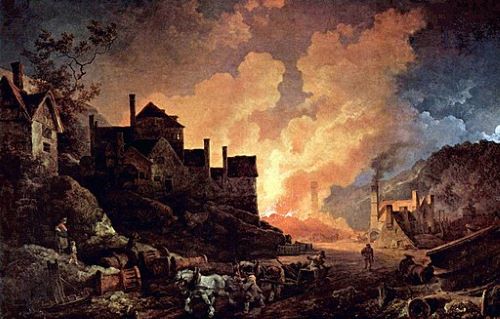The inventions of the Industrial Revolution are those artifacts or creations that were developed between 1760 and 1840, that is, during the process of economic, technological and social transformation initiated from the eighteenth century in Britain that later spread throughout Anglo-Saxon America and for Western Europe.
The Industrial Revolution is considered one of the most important phenomena in the history of mankind, since it modified almost every aspect of daily life. For example, it involved the multiplication of agricultural production and the increase in per capita income as never before.

All this was possible thanks to technological innovations, which supplanted manual labor and animal traction by complex manufacturing and transport machinery. The following describes some of the most important inventions of this era, along with their corresponding creators:
Main inventions of the Industrial Revolution
1. Steam pump
It was invented by the Englishman Thomas Savery (1650-1715) in 1698. This creation constituted a monumental advance within the mining industry, since before its invention groundwater was a serious problem for mining works. This happened because the existing pumps did not have the necessary capacity to extract water from those depths.
Savery’s machine consisted of a very simple device: it was a tank that was connected to two pipes and a boiler. One of the pipes was connected to the water from the mine that was desired to be extracted and another was facing the outside.
The steam pump acted as follows: a valve that connected the boiler to the tank must first be opened; This, when completely filled with water vapor, allowed the air to flow outside through a non-return valve.
2. Drill bit
It was built by the English inventor and agronomist Jethro Tull (1672-1741) in 1701. It is considered that Tull was a pioneer in scientific agriculture thanks to this design, which increased the speed of crop production.
The seeder was robust and efficient; it allowed to sow and plow extensive fields using little labor. In addition, the seeds were distributed regularly, which implied a more homogeneous growth of the crops and greater use of the soil.
3. Steam engine
Designed by the English inventor and blacksmith Thomas Newcomen (1663-1729) in 1705. Newcomen is known by some as the father of the Industrial Revolution, as he was a pioneer businessman in the field of technological innovation.
His machine was actually an improvement on Thomas Savery’s invention. In fact, they worked in a similar way: both had to create a vacuum in a tank and cool the water vapor. However, Newcomen’s invention had a cylinder that pulled a beam, which was used as a rocker and formed a much more efficient kind of alternative pump.
4. Mercury thermometer
It was devised by the German engineer Daniel Gabriel Fahrenheit (1686-1736) in 1714. His invention consisted of a type of thermometer that allowed to measure the temperatures of any selected material by means of a white reflective bulb, which prevented the absorption of radiation present in the environment.
That is, the mercury thermometer calculates the actual air temperature without the result being affected by any other element present in the environment that radiates heat.
5. Leyden bottle (condenser)
It was devised by the German physicist Ewald Georg von Kleist (1700-1748) in 1745 and is considered the first electric capacitor. It is an electrical device that, through a glass bottle, allows certain electrical charges to be stored.
Its characteristics are as follows: by means of a metal rod and aluminum or tin sheets, the internal reinforcement is formed. On the other hand, the outer armor consists of a layer that covers the glass bottle. This bottle works as an insulating material between both layers of the condenser.
6. Spinning machine
Designed in 1764 by British carpenter and weaver James Hargreaves (1720-1778). His machine is also known as Jenny spinning and was built to meet the demand for cotton yarn, the offer of which could not be satisfied by single-wire spinning wheels.
Hargreaves realized that, if several aligned threads were placed and a wheel was positioned horizontally, several threads could be spun at the same time. His invention brought him inconveniences with traditional spinners, who claimed that they would lose their jobs due to the effectiveness of the new spinner.
7. Hydraulic spinner
The English industrialist Richard Arwright (1732-1792) was the one who designed it in 1769. It was a type of spinning machine that was driven by a hydraulic wheel.
In addition, it consisted of a frame that allowed the simultaneous use of up to 128 spinning mechanisms, which significantly increased the quality and production of the yarn manufactured at industrial scales. Its original name was water frame.
Hydraulic spinner model. Source: [CC BY-SA 3.0 (http://creativecommons.org/licenses/by-sa/3.0/)]
8. Automobile
Many consider that the first car was made by the Frenchman Nicolas-Joseph Cugnot (1725-1804) in 1770. However, this is still in dispute. What can be said is that Cugnot made several models of vehicles that were powered by steam engines and whose objective was to drag heavy cannons to speed up the fighting.
9. Steamboat
It was designed by the American John Fitch in 1787. Its creation was successfully tested during a navigation on the Delaware River in 1787, which allowed Fitch to obtain a patent in 1791. However, his idea could only become profitable decades later thanks to the improvements implemented by Robert Fulton.
10. Gas turbine
Made by the British John Barber (1734-1793) in 1791. This machine allowed to increase the flammable air with the aim of obtaining movement to facilitate metallurgical work. Barber’s design included a turbine, a combustion chamber and an alternative gas compressor.
11. Gas lighting
The Scottish inventor William Murdoch (1754-1839) was the first to use the flammability of the gas in order to apply it in lighting. Murdoch first managed to light his own house in 1792, then in 1798 he used the gas to illuminate some buildings of the Soho Foundry. In 1802 he made a public show, surprising the local population with his lighting.
12. Cotton gin
It was devised in 1793 by Eli Whitney (1765-1825), an American inventor. It is a simple machine that quickly and easily separates cotton fibers from their seeds, which are usually sticky.
The ginner works through a screen and wire hooks that push the cotton through the screen, while small brushes eliminate loose threads to avoid jams.
13. Lithography
The lithography was invented by the German Johann Aloys Senefelder (1771-1834) in 1796. It is a printing procedure that allows you to draw a text, drawing or photograph on a metal plate or a limestone. It is currently almost obsolete; It is only used to obtain and duplicate artistic works.
14. Jacquard loom
It consists of a mechanical loom invented in 1801 by the Frenchman Joseph Marie Jacquard (1752-1834). It worked by using punched cards, which allowed knitting patterns on the fabrics. For this reason, even the most novice users could make the most complex designs.
Each perforated card corresponded to a line of the design and its placement together with the other cards worked to determine the ligament with which the weaving weave.
15. Electric battery
It was invented by the Italian Count Alessandro Volta in 1799. In general, it can be established that an electric battery is a commercial and industrialized format of the voltaic cell. It consists of a device capable of converting chemical energy into electrical energy through a transient chemical process.
In other words, it is a primary generator whose energy becomes accessible through two terminals that the battery has, called electrodes, poles or terminals.
16. Propeller
It was prepared by the American John Stevens (1749-1838) in 1804. During his lifetime, Stevens developed many steamboats and developed various designs of naval engines and boilers. In 1792, the inventor obtained a patent for the creation of two propeller engines, which allowed his steamship to navigate the Hudson River using a high pressure multitubular boiler.
17. Print press
The printing press was invented by the German Friedrich Koenig (1774-1833) in 1810. It was a machine that used a double cylinder with the energy provided by a steam engine. Koenig’s goal was to replace human force with the machine, which allowed increasing the dissemination of printed texts among the less well-off sectors of the population.
18. Railway line
It was devised by the British George Stephenson (1781-1848) in 1814. This mechanical engineer is considered “the father of the railroads”, since he designed several railway lines during his existence, such as Liverpool-Manchester.
It is important to add that Stephenson was not the first to build a locomotive, since in 1813 William Hedley had already developed this invention, however, the creation of Hedley was unsuccessful. Therefore, George must actually be studied as the most successful pioneer in railway inventions.
19. The bicycle
In 1816, the German researcher Karl Drais (1785-1851) developed the first two-wheel velocity, currently known as a bicycle. It was a kind of small car made up of a handlebar and two wheels, placed one behind the other.
It was a vehicle that, in order to function, required man-machine interaction. The person had to sit on a saddle and had to place his hands on a wooden stick that was attached to the front wheel. This rod was what determined the direction of the vehicle.
20. The typewriter
In 1829, the American inventor William Austin Burt (1792-1858) patented a typographer, considered by many to be the first modern typewriter.
It consisted of a mechanical device consisting of a set of keys that, when pressed by the user, printed characters in a document. The person who used this machine was known as a typist.
21. Sewing machine
It was devised by the French Barthélemy Thimonnier (1793-1857) in 1829. This machine was characterized by its ability to imitate hand sewing. It was made of wood and used a barbed needle, which passed through and under the fabric to grab the thread. These spikes also pulled up in order to form a loop.
22. Dinamo (electric generator)
It consists of an electric generator that transforms the magnetic flux into electricity through a phenomenon known as electromagnetic induction. It was devised by the British physicist Michael Faraday (1791-1867) in 1831.
This invention is also known as the Faraday Disk and consists of a homopolar generator that uses a copper disk, which rotates between the entrances of a magnet, which generates current continuously.
23. The Roman scale
It was designed by the American Thaddeus Fairbanks (1796-1886) in 1830. This scale allowed to weigh large targets with great precision. Prior to this invention, a balance beam was required to specify the weight of the objects, so that the heaviest objects could not be calculated accurately.
24. Electromagnet
In 1825, the British physicist William Sturgeon (1783-1850) built the first electromagnet. In addition, he designed the first practical electric motor. The electromagnet consisted of a piece of iron that was shaped like a horseshoe and was wrapped in a coil.
Sturgeon managed to regulate this electromagnet, which meant the beginning of the use of electric energy in controllable and useful machines. Therefore, this invention established the foundations of what would later be electronic communications.
25. Portland Cement
In 1824, the British Joseph Aspdin (1778-1855) manufactured Portland cement, which consisted of an artificial stone used as a building material. It is a hydraulic binder that is mixed with aggregates, staple steel fibers and water, elements have the property of forming a durable and resistant mass known as concrete.
References
- Dietz, F. (1970) The industrial revolution. Retrieved on December 23, 2019 from books.google.com
- Mokyr, J. (2018) The british industrial revolution. Retrieved on December 22, 2019 from content.taylorfrancis.com
- SA (2010) Five inventions of the Industrial Revolution that changed the world. Retrieved on December 22, 2019 Telesur: Telesur.net
- SA (2018) Main inventions of the First Industrial Revolution. Retrieved on December 22, 2019 from unprofesor.com
- SA (sf) Inventions and inventors during the industrial revolutions, 1698-1994. Retrieved on December 22, 2019 from ocw.unican.es
- SA (sf) Industrial revolution. Retrieved on December 23, 2019 from es.wikipedia.org




